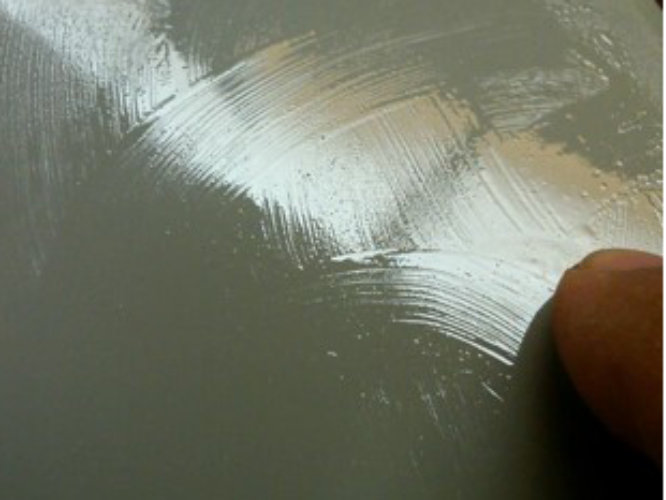How to Identify, Prevent & Remove Amine Blushing Epoxy
What is an amine blush? Our experts explain how to prevent and remove amine blush from epoxy.
Learn More or Get a Free Flooring Evaluation

Amine blush is a chemical reaction that occurs between water, carbon dioxide, and the amine component of epoxy coatings. Amines are hygroscopic, which means that they tend to absorb moisture from the air and are prone to react with available moisture and carbon dioxide. When some epoxies are applied under low temperature and/or high humidity conditions, a side effect of the curing reaction may appear on the coating surface. If the surface is to be overcoated, the presence of amine blush can act as a bond breaker between the coating layers. Aside from the serious issue of decreased adhesion of subsequent coats, amine blush can cause multiple other issues including aesthetics, an increased tendency to yellow, decreased stain resistance, lower gloss retention, softening of the coating, reduced chemical resistance to mention a few. In addition, when the amine component reacts with water and carbon dioxide, it can leave some of the epoxy resins unreacted. This leaves the coating in an under-cured state and the coating may be compromised.
Identifying Blush
Amine blush can be described as a sticky, oily, or waxy appearance on the surface and can appear as greasy white spotting, or even salt-like, with crystalline deposits. Visually it can also be cloudy, milky, or grey coloured, with opacity and dullness. A more troublesome aspect of blush is that it may not be evident or even visible. Not only is blush sometimes not evident, but the blushing can also be a highly localised phenomenon because of uneven ventilation and/or many other factors. One area may be perfectly fine, while not ten feet away, a bond-inhibiting blush has occurred that will cause certain delamination of successive coats. Carefully survey the entire area to be coated before installation of a topcoat if blush is suspected. Fortunately, there are field tests that aid in the immediate identification of amine blush (carbamates) on a surface. While not a go/no-go test, these tests will help you determine the presence of amines on the surface. A quick internet search on “Elcometer 139 Amine Blush Swab Test Kit” or “The TQC Amine Blush Kit” will give you plenty of options and information.
Preventing Blushing
The best way to prevent an amine blush is to monitor and control the environmental conditions prior to, during and after application. Only apply epoxy floor coatings when the air and surface temperatures will remain within the recommended application temperatures found on the materials PDS. Avoid condensation by staying ideally at least 3°C above the dew point prior to and throughout the application and cure. The storage of the hardener and resin within the same temperature range prior to use is also recommended. The use of fuel-burning heaters such as a salamander or torpedo heaters is not recommended. This method will heat the area, but it will also introduce moisture and carbon dioxide into the area, increasing the opportunity for blushing. A very effective method for reducing moisture and lowering dew points, is using dehumidification equipment.
Remediating Blushing
Because the amine blush is water-soluble, the use of solvents to remove a blush is not very effective. However, the use of specialist dish soap, laundry detergent, TSP or a general degreaser in warm water with a stiff bristle broom or a scrub pad works well to remove and suspend the amine blush from the epoxy surface. It is recommended to repeat the cleaning process once or twice, prior to rinsing thoroughly with warm water, allowing the surface to dry before visual inspection and retest for amine blush. Recoat windows may be missed so abrading (sanding) may be necessary before application. Abrading should be avoided until the removal of the blush.
Discover More
Industry Expertise and Innovation
See how we help customers find customised solutions for their project and application challenges.
Product Lookup
Find out more about our innovative coatings for a variety of industries.
FIND A SYSTEM



